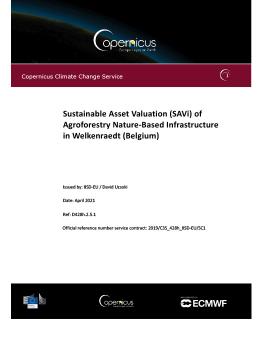
Sustainable Asset Valuation (SAVi) of Agroforestry Nature-Based Infrastructure in Welkenraedt (Belgium)
-
The net benefits of the agroforestry project are estimated at EUR 3.9 million over a 20-year lifetime period for an investment cost of EUR 607,629. This is due to positive externalities, avoided costs, and additional potential revenue streams, such as, for example, fodder and wood pellet production.
-
Due to climate change, these benefits will only increase further and make agroforestry projects even more economically attractive. For example, agroforestry has a cooling effect that reduces heat stress on livestock, improving milk production and thus farmers' revenues.
This report describes the Sustainable Asset Valuation (SAVi) assessment of an agroforestry project in the municipality of Welkenraedt, Belgium. Agroforestry is nature-based infrastructure (NBI) that aims to maintain and restore soil productivity, combat erosion, maintain high water quality, and strengthen climate resilience in the area. Agroforestry is included in the municipality’s climate plans.
You might also be interested in
IISD Annual Report 2023–2024
While IISD's reputation as a convenor, a trusted thought leader, and a go-to source on key issues within the sustainable development field is stronger than ever, the work happening outside the spotlight is just as valuable.
Sustainable Asset Valuation (SAVi) of Stormwater Infrastructure Solutions in Johannesburg, South Africa
A SAVi assessment of grey-green infrastructure upgrade options for stormwater infrastructure in the Paterson Park Precinct, Johannesburg.
Sustainable Asset Valuation (SAVi) of Paterson Park's Building Infrastructure: City of Johannesburg (South Africa)
The assessment of Paterson Park's building infrastructure is one of the use cases demonstrating the value of integrating climate data from the Copernicus database into SAVi.
Sustainable Asset Valuation (SAVi) of a Small-Scale Tree Planting Initiative in Côte d'Ivoire
This report analyzes the social, economic, and environmental outcomes of a small-scale tree planting initiative at schools in Côte d'Ivoire.